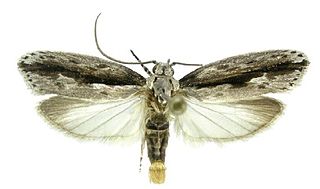
Pyramidobela quinquecristata is a moth in the family Oecophoridae. It is found in the mountains around the margins of the Great Basin in North America.
Ethmia coquillettella is a moth in the family Depressariidae. It is found in North America along the southern and inner central coast range of California and has also been recorded from interior British Columbia.
Ethmia brevistriga is a moth in the family Depressariidae. It is in California, United States.
Ethmia albistrigella is a moth in the family Depressariidae. It is found in North America from southern British Columbia southward in the Rocky Mountains to south-western Colorado and into the Wasatch Range in northern Utah. On the Pacific coast it ranges through western Washington and Oregon into the mountains of California. Subspecies icariella is an Arctic-Alpine zone race which has only been recorded from California.
Ethmia nadia is a moth in the family Depressariidae. It is found in California.
Ethmia apicipunctella is a moth in the family Depressariidae. It is found in North America from southern Texas and Nuevo León to eastern Arizona and adjoining areas of Mexico. In the north, the range extends into Colorado and southern Wyoming.

Ethmia arctostaphylella is a moth in the family Depressariidae. It is found in the United States and Mexico from southern Oregon and northern California, southward to the Sierra San Pedro Martir in Baja California and eastward in southern Nevada and Arizona. The range possibly extends northward in Oregon and into Utah following the distribution of its host plants.
Ethmia timberlakei is a moth in the family Depressariidae. It is found in California, United States.
Ethmia semitenebrella is a moth in the family Depressariidae. It is found in North America from Colorado, Utah, New Mexico and Nuevo León in Mexico to Arizona and southern and eastern California.
Ethmia geranella is a moth in the family Depressariidae first described by William Barnes and August Busck in 1920. It is known only from the United States in the western edge of the Colorado Desert in California's San Diego County and the Ivanpah Mountains of the eastern Mojave Desert.
Ethmia discostrigella, the mountain-mahogany moth, is a moth in the family Depressariidae. It is found from the western United States, south into Mexico.

Ethmia zelleriella, or Zeller's ethmia moth, is a moth in the family Depressariidae. It is found in eastern North America, from southern Ontario and Quebec through the Ohio Valley and southern Appalachian regions to central Texas.

Ethmia nigritaenia is a moth in the family Depressariidae. It is found from southern Mexico, Guatemala and Honduras to north-western Costa Rica.

Ethmia catapeltica is a moth in the family Depressariidae. It is widespread in Central and northern South America, from southern Mexico to Bolivia.
Ethmia longimaculella, the streaked ethmia moth, is a moth in the family Depressariidae. It is found from southern Canada and the northern United States east of the Rocky Mountains. In the Midwest, the range extends south to Texas.
Ethmia semiombra is a moth in the family Depressariidae. It is found in Texas and Mexico.
Ethmia albicostella is a moth in the family Depressariidae. It is a widespread species in the Rocky Mountains and Sierra Madre Occidental of Mexico, ranging from southern Manitoba, Saskatchewan, and Montana through the southern Rocky Mountain states at moderately high elevations and mountains of western Mexico at least south to Durango.
Ethmia mirusella is a moth in the family Depressariidae. It is found in the United States from Kansas and Oklahoma to central and western Texas.
Ethmia marmorea is a moth in the family Depressariidae. It is found in North America in the lower parts of the Great Basin mountain ranges and the Rocky Mountains from south-eastern British Columbia and the eastern parts of the Pacific states to northern and central Colorado and central Chihuahua.
Ethmia sphenisca is a moth in the family Depressariidae. It is found in North America in the high mountains of Arizona and north-western and central Mexico.





